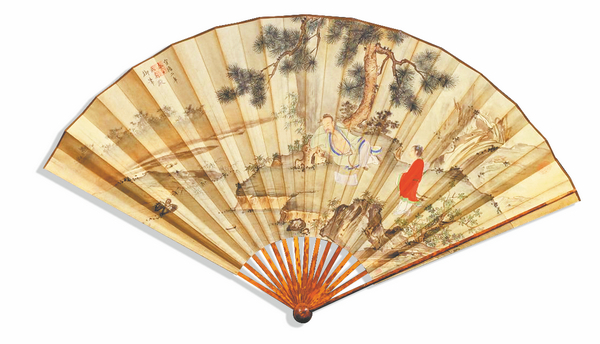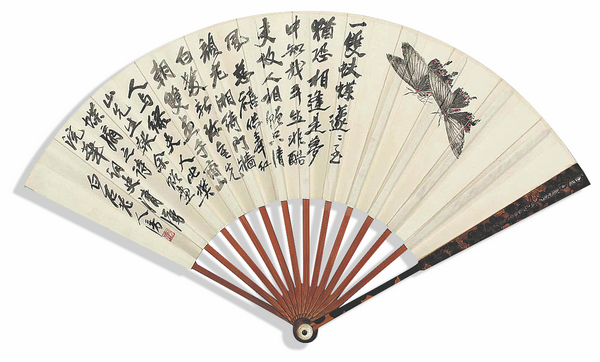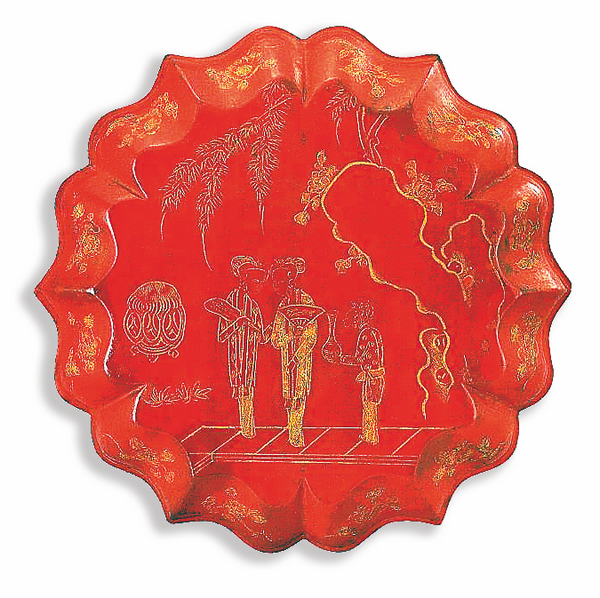Cultural roots spread in elegant style

A fan painted by Emperor Xuanzong (1399-1435), from Beijing's Palace Museum. (Photo/CHINA DAILY)
One day in the early 1920s, Luo Yinggong (1872-1924), one of China's most talented playwright-cum-Peking Opera impresarios of the time, bought an unpainted folding fan from a powerful collector-official with 40 gold ingots.
The main ribs of the fan are carved out of a special type of bamboo whose round, dark-colored patterns, resulting from microorganism infection, were reputed to have been formed as the sad tears of two bereaved ladies fell on the plant.
They were grieving the death of their husband, the legendary Emperor Shun whom some Chinese historians believe lived between 2200 and 2300 BC.
Equipped with the fan, Luo then knocked on the door of the much-revered painter Qi Baishi (1864-1957), whose brilliantly painted pair of butterflies would later appear on one side of the fan, along with his calligraphic transcription of a butterfly-themed poem by another of his equally renowned contemporaries.
There was now only one thing left to do: to record the event on the other side of the fan, which Luo did himself, noting that the fan "was meant as a birthday gift for Mr Mei" (Mei Lanfang, a master performer of Peking Opera).
Having written in the same inscription that "a thing (of beauty) will certainly be passed down across generations", Luo probably wouldn't be surprised when the fan was put up for bid nearly 90 years later during an auction held in Beijing in November 2011, where it fetched 3.22 million yuan ($444,100).
Yang Danxia, an expert on ancient Chinese painting from Beijing's Palace Museum, was at the auction preview.
"If anything, the story offers glimpses into a rather exclusive circle populated by Beijing's cultural elite at the time," she says.
One gathering place for its members was Lai Jin Yu Xuan Tea House, located today inside the former imperial altar-turned Zhongshan Park in central Beijing. The name of the tea house is a reference to a piece of writing by eighth-century poet Du Fu, on friendship.
"It was no coincidence that the tea house was where the daily activity of dou shanzi (fan contest) took place," says Yang.
According to her, a person entered his fan into this contest the moment he stepped into the tea house, the arrival announced by the crisp snap of a fan opening at a flick of the owner's wrist.
"Think about a Rolls-Royce coming to a halt in front of a luxury hotel, with its powerful engine letting out a deep roar. What that car did for its owner, a fan could do," she says.
A folding fan, apart from fanning gentle waves of cool air, could also be a veritable work of art, a statement accessory testifying to the standing of its carrier, especially in cultural circles.
"That's what set the folding fan apart from other types of fans that had appeared in Chinese history. For example, the circular-shaped tuanshan, or palace fan, was used almost exclusively by women," says Yang.
According to Yang, despite their modern usage, both the folding fan and the palace fan probably originated as items of etiquette.
Held up to face level, they served as small screens between a fan holder and another person who was most likely in a much higher position, so that the former wouldn't be looking up directly into the latter's eyes during a meeting between the two.

A fan painted by contemporary painting master Qi Baishi (1864-1957) was given to Peking Opera maestro Mei Lanfang (1894-1961) as a birthday gift. (Photo/CHINA DAILY)
"This was especially true when an audience was given by an emperor to his subjects. It is believed that in ancient Japan, court officials may have initially done so with a bamboo slip, with its official-facing side written with a summary of what the man had planned to say to the emperor," Yang says.
"Sometimes one needs a few reminders to appear totally calm and prepared in front of the big boss.
"And when you are holding more than one such slips and spreading them out in front of your eyes, you get a fan."
In 1978, a multilayered, red-lacquered makeup box was discovered in Changzhou city, eastern China's Jiangsu province, in a tomb dating to the Southern Song period (1127-1279).
In the design on its cover, highlighted in gold, two well-dressed young ladies appear in the middle of a manicured garden, waited on by an attendant. While the one on the left is holding a palm leaf of a fan, the one on the right holds a painted folding fan whose bamboo ribs are clearly discernible.
"This is the earliest archaeological proof so far found for a folding fan, although it's essentially a visual depiction. As to real objects, the earliest ones we have now date back to the early Ming Dynasty (1368-1644)," says Yang, pointing to a fan within the collection of the Palace Museum, which is believed to have been painted by Emperor Xuanzong (1399-1435), the fifth emperor of Ming.
With a maximum width of 151 centimeters, this particular one is a lot bigger than an average folding fan, and was probably meant for the wall. On one side of it, the emperor painted a loosely robed scholar-recluse reclining under a pine tree, a hand-scroll of writing lying on the ground nearby.
"The image was embedded in China's literati culture, which celebrated a life lived away from all the chaos and trappings of the world," says Yang.
"Throughout China's Ming and Qing (1644-1911) dynasties, painting, calligraphy, and poetry were dubbed 'the three perfections' and were required of a cultured man. A folding fan was carried around as a showcase, if not of a man's own literary and artistic talent, then at least his taste in such matters."
That might explain why, within those six centuries, many who had established themselves in the overlapping worlds of art and poetry had created fan art.
"One challenge lies with compositional arrangement: You have to be mindful of the shape of a fan and the limited amount of space you are given," says Ma Xiangjun, a Suzhou-based calligrapher who has inscribed more than a few folding fans made by Xu Jiadong, a much-celebrated local fan-maker.
"Meanwhile, a fan is opened, bit by bit. And whoever is creating fan art needs to be able to visually guide his viewers through that experience."
"A window with a view" — that's Yang's metaphor for the framed picture contained within the fan's surface. "What is that view made up of? Sometimes it could just be a bough laden with flowers; other times, it comprises a serene landscape of misty mountains and meandering rivers," she says.
One contemporary Chinese painter who has worked for decades with ink and brush and has often painted folding fans is Li Yunlei.

A red lacquer box from the Southern Song period (1127-1279), featuring a lady holding a folding fan on its cover, from Changzhou Museum in Jiangsu province. (Photo/CHINA DAILY)
"A fan is half of an umbrella," Li remembers hearing this saying growing up in Hangzhou city, East China's Zhejiang province, where the rain is copious.
That was in the early 1980s when locally made folding fans with bamboo ribs were exported in large quantities in exchange for foreign currency. Yet, Li had to wait for a few more years for similar products to be sold in local stores. In previous decades, folding fans, considered part of "the trivialities of a bourgeoisie life", had disappeared from view. And when they did reappear, Li the middle-school student immediately bought one.
"I walked through the campus waving a fan, making myself the subject of ridicule for my fellow students," he recalls, laughing.
Having held a small exhibition for his painted fans in June, Li describes his personal style as "merging the traditional with the modern, with an element of quirkiness thrown in".
"As an artist, I'm very fond of water. When I'm painting a fan, I love to see water pool up a bit within its pleats," he says.
Next year, he plans to invite a group of artists to Anji county in Zhejiang, where there's a local fanmaking industry. "They'll be painting folding fans with whatever material they choose and in whatever style they prefer," he says.
"I want to show them the various possibilities with a Chinese folding fan."
With that being said, Li notes the folding fans' growing popularity with the younger generation who find them perfect matches for their period costumes. "At the beginning, they may simply consider it cool to flutter a fan, like I did in middle school. But eventually, some of them will be drawn into the world behind it, where the beauty is in the details," he says.
Asked for an example, Li points to the soft crystalline shimmer given out by the papery surface of a fan. "The effect has resulted from sprinkling and pressing ultrathin flakes of silver onto the pristine paper," he says.
"People call it 'rain and snow'."
Photos
Related Stories
- Cross-Strait calligraphy exhibition opens to promote cultural exchanges
- An American finds second home in China's millennia-old city
- Indonesian Chinese teacher spreads her love for Chinese culture to more youngsters
- Feature: Young Greek athletes experience Chinese culture through martial arts
- Children learn intangible cultural heritage during summer vacation
- Chinese sports culture exhibition held in Paris
Copyright © 2024 People's Daily Online. All Rights Reserved.









